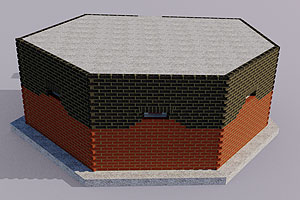Trenchcam - new angles on a preserved trench
Posted: 7 March 2009 20:59
I went back to the intact trench I found last week in order to get better photographs and to try and understand construction details.
I was better prepared to take photos in the trench, having rigged up a means whereby I could bolt my camera to my walking pole and lower it to the trench floor through the small access hole to film from specific angles; the photo below allows me to modify some points I made previously.

By having a modicum of control over the angle, I managed to point the camera upwards to investigate the covering and I now see that this consists of only one sheet of corrugated iron and not a couple as I previously thought. The wrinkle in the cover sheet (where the grass hangs down) cast a shadow that in my previous photo appeared to be an overlap between two sheets of iron, whereas there is only one sheet.
What's also interesting is the way that the cover has been placed behind the iron forming the rear wall of the trench and bent over; contrary to what I said before, the angle pickets on this wall appear to have been deliberately displaced to enable this, rather than them rusting and shearing off.
The question is, why was it done this way? Why were the pickets displaced, seemingly to accomodate this method of covering the trench? Some neighbouring trenches have their pickets still in position, while others have theirs also at an angle, seemingly to hasten the inward collapse of the rear wall, thus neutralising the trench. If displacing pickets was a method of trench destruction, why was this one given a cover that seems to have had the opposite effect?
It seems to me that covering the trench after displacing pickets involves more work than just removing the iron retaining the rear wall and shovelling in some spoil from the slope to make the trench safe and so I'm at the point at which I'm thinking that the army was responsible for this covering, although why is not clear.
The video at right gives a quick tour of the trench; 'Trenchcam' is purely exerimental, the camera being lowered on the pole whilst filming, internal lighting being provided by a torch.
Somehow, I managed to turn the camera through 360° whilst lying prone with both arms through the hole, a torch in my left hand to illuminate the trench interior; if I can get hold of a brighter lighting system, I may try to remake this video.
Note: Please don't email me asking about the possibility of this being a Home Guard Auxiliary Unit Operational Base; it's not. This is an ordinary army slit trench constructed to a standard design and in the middle of a defended locality. Although I don't know why it was covered over, I'm 99.9% certain there is no 'secret' side to it!
- Pete

Email:
Blog Latest

Bishopstone reveals its pillbox secrets
18 October 2021

Pillbox or Observation Post?
10 June 2020

Uncovering the hidden secrets of a pillbox
8 June 2019

Review of 2018
31 December 2018

Wartime Christmas in East Sussex (2)
24 December 2018
Jargon-buster
Angle picket
Iron stake made in several lengths used for construction of barbed wire obstacles or to hold trench revetment in place.
Defended locality
An area defended by a force (e.g. a platoon) occupying a series of defence works, normally within a barbed wire perimeter. Localities were designed for all-round defence and usually fitted in with a coordinated scheme of neighbouring localities.
Slit trench
Small, narrow trench designed to provide protection against shrapnel and other battlefield hazards. Technically distinct from a weapon pit (which was intended soley as a defensive position) slit trenches were also used as defence works.
This site is copyright © Peter Hibbs 2006 - 2024. All rights reserved.
Hibbs, Peter Trenchcam - new angles on a preserved trench (2024) Available at: http://pillbox.org.uk/blog/216611/ Accessed: 27 July 2024
The information on this website is intended solely to describe the ongoing research activity of The Defence of East Sussex Project; it is not comprehensive or properly presented. It is therefore NOT suitable as a basis for producing derivative works or surveys!